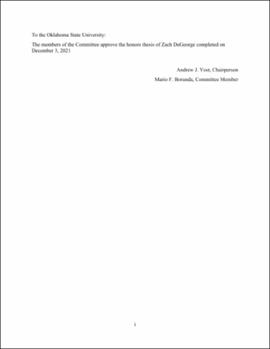| dc.contributor.author | DeGeorge, Zach | |
| dc.date.accessioned | 2022-01-04T15:38:41Z | |
| dc.date.available | 2022-01-04T15:38:41Z | |
| dc.date.issued | 2021-12-03 | |
| dc.identifier | oksd_degeorge_HT_2021 | |
| dc.identifier.uri | https://hdl.handle.net/11244/332587 | |
| dc.description.abstract | Quantum dots are semiconducting particles on the nanometer scale which exhibit unique size dependent electronic and optical properties due to the quantum confinement phenomenon. Over the past several years colloidal quantum dots have been garnering more attention with their rise in photovoltaic device performance and power efficiency, from 3.5% in 2010 to 16.6% in 2019. Many of the attempts to improve photovoltaics’ overall device efficiency have been focused on device architecture and materials improvement. Doping chalcogenide-based quantum dots with transition metals like Mn or Co has been shown to dramatically improve device efficiency and overall light absorption, respectively. In this research project, Mo-Mo-dimers (Mod) are doped into ZnS quantum dots using a wet chemical method. The quantum dot’s optical properties, crystallinity, and size are explored using optical absorption spectroscopy, X-ray diffraction, and transmission electron microscopy. Then the quantum dots are incorporated, via successive ionic layer adsorption and reaction, into a solar cell architecture to form a p-n junction with a hybrid halide perovskite film. The hybrid halide films in this project consist of CH3NH3PbI3 due to their reported high efficiencies in photovoltaic cells. The overall goal is to observe and interpret changes in the open-circuit voltage and short-circuit current of a working photovoltaic cell in order to determine if Mod doping has any efficacy when combined with hybrid halide perovskite films. | |
| dc.format | application/pdf | |
| dc.language | en_US | |
| dc.rights | Copyright is held by the author who has granted the Oklahoma State University Library the non-exclusive right to share this material in its institutional repository. Contact Digital Library Services at lib-dls@okstate.edu or 405-744-9161 for the permission policy on the use, reproduction or distribution of this material. | |
| dc.title | Mo-Mo dimer doped ZnS quantum dots and their influence on hybrid halide perovskite heterostructure solar cells | |
| osu.filename | oksd_degeorge_HT_2021.pdf | |
| osu.accesstype | Open Access | |
| dc.type.genre | Honors Thesis | |
| dc.type.material | Text | |
| dc.contributor.director | Yost, Andrew J. | |
| dc.contributor.facultyreader | Borunda, Mario F. | |
| thesis.degree.discipline | Applied Physics | |
| thesis.degree.grantor | Oklahoma State University | |
